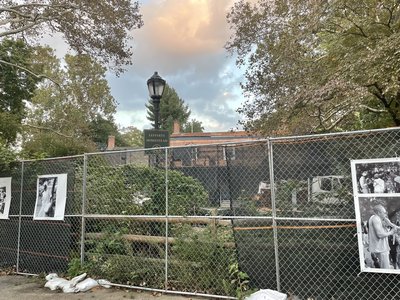Nestled in the Northeast corner of Prospect Park, the Lefferts Historic House offers Brooklynites insight into the borough’s colonial past. Operated jointly by the Prospect Park Alliance and the Historic House Trust, the Lefferts Historic House Museum features a working garden, farm plots, historic artifacts, and period rooms that recreate life in the 17th century. However, the museum has done very little to acknowledge the experiences of enslaved African Amercians and the indigenous Lenape who were forced to work on the land.
A new initiative is hoping to change that.
As the Lefferts House undergoes renovations ahead of a planned 2023 reopening, the Prospect Park Alliance has launched the “Re-Imagine Lefferts Historic House” initiative to re-envision the mission and programming of this historic house museum. The Alliance is currently gathering input from historians, Black and indigenous communities, and current Brooklyntities to more accurately recognize the role the house played as a site of slavery, and tell the stories of enslaved Africans and Native Americans who lived and worked the land.
“We want to use this opportunity while it’s closed to reach out to the community and talk about how we can elevate the narrative of enslaved people in a way that is meaningful,” said Maria Carrasco, the Vice President of Public Programs for the Prospect Park Alliance. “We don’t just want to be talking about the Lefferts Family or agriculture or issues that are a little more general, but to talk about the people who actually lived here, including the enslaved people.”
This past week, the Prospect Park Alliance held a public hearing in the park to gather community feedback about the re-imagining initiative. They were joined by representatives from the Dyckman Farmhouse in Manhattan’s Inwood neighborhood, who previously embarked on their own initiative to recover the history of enslaved African and indigenus peoples who lived on the land (titled DyckmanDISCOVERED).
“People would ask why there was no information about the enslaved Balck people who were here,” said a representative from the Dyckman House. “The information gathered in this research helped to tell the story of all the people who spent time in this house. The simple act of learning the names of the people who were there is very powerful.”
A number of local residents and members of community organizations offered their own insight into the re-imagining project, including suggestions about how Lefferts House could work alongside other historic sites in Brooklyn to create a more comprehensive body of research about Black and indgenous history in the borough.
“This park is really my backyard, especially since the start of the pandemic,” said Kendall Julian, a Trinidadian immigrant currently living in Flatbush. “We should take this beautiful park and building and integrate it into our community the way it should be.”
“What we’ve learned through research and the past years is the importance of learning names. That is critical to reframing history,” said Billy Holiday, the former director of the Lefferts Historic House. “We don’t just want to say enslaved Africans and the Lenape while the Lefferts get names. Some people shouldn’t have a name while others don’t.
Father Sheldon Hamblin from St. Paul’s Episcopal Church in Flatbush specifically called on the Lefferts House to collaborate with organizers at the Flatbush African Burial Ground, the last remaining burial site for enslaved African Americans in the city.
“It [the burial ground] is slated for real estate development, so I would be curious to see if we could work with Lefferts House as it develops this museum to help preserve that space,” Hamblin said. “When the community knows about these things there is pushback, so we must get the word out.”
Event attendees also suggested that the Lefferts House work alongside the Weeksville Heritage Center in Crown Heights, a preserved African American neighborhood founded by slaves in the 19th century.
“This history shouldn’t be invisible. It is literally hidden beneath our feet,” said Brenda Becker, a local historian and blogger. “40% of the population of Flatbush in 1776 were enslaved African Americans. Nobody knows that.”
At the end of the event, people were encouraged to write down ideas that they thought could enhance the “Re-Imagine Lefferts Historic House” initiative. Suggestions included renaming the house, including a land-acknowledgement statement, and allowing historians to use the house and its resources to improve the body of research about Brooklyn’s Black and indigenous history.
The Lefferts Historic House restoration is funded by $2.5 million from the Brooklyn Delegation of the New York City Council. The project will replace the building’s roof, restore its interior, and repair paths and drainage surrounding the house.
In addition to collecting expert and community input, the “Re-Imagine Lefferts Historic House” initiative is currently displaying an exhibition of work by the preeminent photographer Jamel Shabazz on the house’s construction fencing. The photographs depict the various ways Brooklynites have enjoyed their free time and celebrated inside of Prospect Park.



